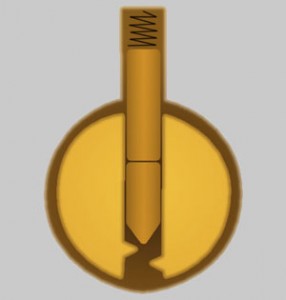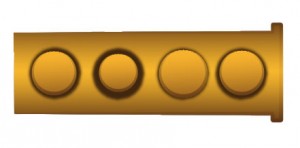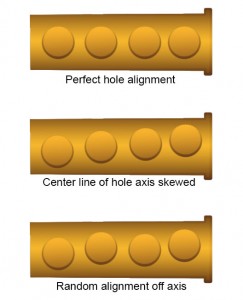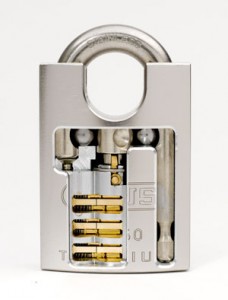We’re able to pick locks because the world isn’t a perfect place. Every machining operation produces a product with small defects but still within specified tolerances. If you machine a hundred parts, no two are precisely the same, no holes identical in diameter, no line perfectly straight. Yes, the variations may be small, but they’re there and they’re cumulative when you assemble all the different parts into a lock. THAT accumulation of defects is the crack that we are trying to exploit. Our tools and senses allow us to detect the subtle differences between pins, cores, spring tension and feedback – all of which contain defects and remnants from the manufacturing process.
Lock Design and Parts

The “body” or “bible” is the largest component of the lock and holds all the other components together. It’s carefully machined to contain the core (the part the key fits into), as well as the pin cylinders.
 The core” or “plug” is the part that the key slides into. It also has holes that align with the holes in the lock body. The keyway is “broached”, or cut into the core to allow only specific keys to fit.
The core” or “plug” is the part that the key slides into. It also has holes that align with the holes in the lock body. The keyway is “broached”, or cut into the core to allow only specific keys to fit.
“Key pins” are different lengths to fit into the “bitting”, or cuts in the key – that’s why your key looks jagged, like a saw blade.
Pictured: The core (left) and bible from an American Brand padlock.

With the key inserted into the core, the key pins align perfectly with the different depth cuts in the key and align perfectly with the top of the core. This is called the “shear line” because once they align the core and housing “shear” cleanly, allowing the core to rotate and the lock to open.
Pictured: Cutaway of an Abus Titalium padlock showing the core rotated slightly to give a clear view of the six key pins and the spool pins. You can see the ball bearing locking mechanism at the top. Photo Courtesy of Dirk Beumer.

Directly above each key pin is a “driver” pin, which is pushed downwards against the key pin under spring tension. This “drives” the key pins downward into the core to their maximum depth, obstructing the shear line. Until the pins are properly lifted by either a key or a pick, the pins prevent the core from turning because they obstruct the shear line.
In a perfect world picking locks would be impossible because every machining operation would be precisely aligned and the hole diameters identical.
The drawing showing the key pin and driver pushed into the shear line under spring tension. The driver is preventing the core from rotating. Illustration by Quinn Kurenda.
 Every pin would have the same diameter and fit into the cylinders with no extra room left over. If we tensioned a lock with this level of precision, we would find that all pins “bind” at exactly the same point (more on this later). Opening this mythical lock would require either a key, or an incredible amount of luck when simultaneously raising all the pins to the correct level. Thankfully (at least for us!) manufacturing and machining are NOT perfect. In manufacturing it isn’t unusual to discover that each part of the lock is made by a different factory, consolidated and assembled somewhere else.
Every pin would have the same diameter and fit into the cylinders with no extra room left over. If we tensioned a lock with this level of precision, we would find that all pins “bind” at exactly the same point (more on this later). Opening this mythical lock would require either a key, or an incredible amount of luck when simultaneously raising all the pins to the correct level. Thankfully (at least for us!) manufacturing and machining are NOT perfect. In manufacturing it isn’t unusual to discover that each part of the lock is made by a different factory, consolidated and assembled somewhere else. In order for that to work though, all the parts must have “tolerances”.
Pictured: Drawing showing pins manufactured to slightly different tolerances, leaving “slop”. This will cause the pins to bind in a specific sequence, making lock picking possible. Illustration by Quinn Kurenda
The key and driver pin makers have the same type of tolerances for their pin’s diameters. They don’t trust the different housing manufacturers and make their pins slightly undersized, at the bottom end of their tolerance range. By doing that they know none of their pins will be rejected for being too tight in various housings. The only “tight” tolerance applies to key pin length because this is a critical measurement to reach the shear line – so important, in fact, that there are industry standards that all key pin manufacturers abide by.
 The final variable is the core – and this is a biggie. Not only must the holes in the core be the correct diameter, but they must align perfectly with the holes in the housing. Any misalignment, improper spacing between holes, or hole size variations introduce all kinds of problems for the lock. It’ll either flop around with all kinds of slop, or bind up so tight that it’ll never open, even with a key. If the core holes are drilled off axis or misaligned, the precision of the entire lock is compromised.
The final variable is the core – and this is a biggie. Not only must the holes in the core be the correct diameter, but they must align perfectly with the holes in the housing. Any misalignment, improper spacing between holes, or hole size variations introduce all kinds of problems for the lock. It’ll either flop around with all kinds of slop, or bind up so tight that it’ll never open, even with a key. If the core holes are drilled off axis or misaligned, the precision of the entire lock is compromised.
As lock pickers, we count on some level of imprecision because it causes the pins to bind one-at-a-time in a specific “binding order”. The sloppier the tolerances in a lock, the easier it’s to find the binding order and pick the lock open. You can see that a core with off-axis holes would bind sequentially, making our job easier. The total “slop” is a combination of the manufacturing error of ALL the parts combined.
Illustration by Quinn Kurenda.
 Manufacturing precision is a function of money (like everything else in life…). Manufacturing high precision parts requires more expensive machinery, frequent tool changes, quality materials, higher levels of quality control and a lot of rejected parts. To keep costs down and quality high, many lock makers produce everything in-house, thus minimizing variations in tolerances. In general, those companies produce the highest quality, tightest precision, and most difficult-to-pick locks.
Manufacturing precision is a function of money (like everything else in life…). Manufacturing high precision parts requires more expensive machinery, frequent tool changes, quality materials, higher levels of quality control and a lot of rejected parts. To keep costs down and quality high, many lock makers produce everything in-house, thus minimizing variations in tolerances. In general, those companies produce the highest quality, tightest precision, and most difficult-to-pick locks.
Cutaway of an Abus Titalium shrouded padlock showing the ball bearings and actuator in the locked position. Photo courtesy of Dirk Beumer, whose website is: http://www.dirk-beumer.de/, and YouTube Channel is: https://www.youtube.com/
Phil Harnett, aka the “l0ckcr4ck3r” did the fine machine work. His YouTube channel is: https://www.youtube.com/user/
Few companies can afford their own production facility and subcontract manufacturing to the cheapest places they can find – the lowest bidder, usually in China. When all the parts come together into an assembled lock, it’s a product of all the manufacturing errors combined: and is usually sloppy and easy-to-pick.